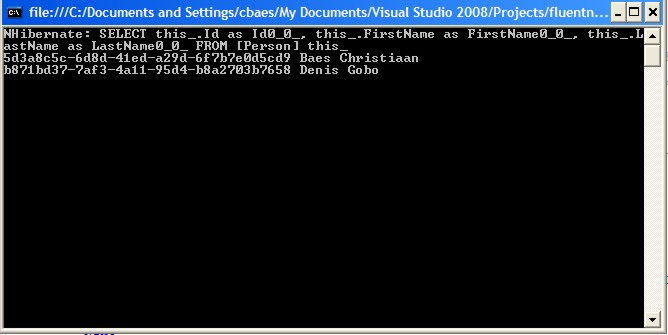I thought it was time to use fluent nhibernate just to keep up. Up untill now I still use the old atributes and nhibernate 1.2.1 because I see no reason to upgrade. It all just works and does what it is supposed to do.
But I don’t want to stand in the way of progress and I want to help the VB.Net community ahead. So that Jeremy can feel a bit better about the VB.Net community ;-).
First thing I did was checkout the trunk versions of nHibernate and fluentnhibernate
Then I made a huge database with one table in it. I used SQL server 2005 64 bits (just in case Ted is reading this) for this.
this is the one table magic.
USE [fluentnhibernate]
GO
/****** Object: Table [dbo].[Person] Script Date: 01/12/2009 10:54:14 ******/
SET ANSI_NULLS ON
GO
SET QUOTED_IDENTIFIER ON
GO
CREATE TABLE [dbo].[Person](
[Id] [uniqueidentifier] NOT NULL CONSTRAINT [DF_Person_Id] DEFAULT (newid()),
[LastName] [nvarchar](50) COLLATE SQL_Latin1_General_CP1_CI_AS NOT NULL,
[FirstName] [nvarchar](50) COLLATE SQL_Latin1_General_CP1_CI_AS NOT NULL
) ON [PRIMARY]```
And I filled up the table with this.
```tsql
INSERT INTO [fluentnhibernate].[dbo].[Person]
([LastName]
,[FirstName])
VALUES
('Baes'
,'Christiaan')
INSERT INTO [fluentnhibernate].[dbo].[Person]
([LastName]
,[FirstName])
VALUES
('Gobo'
,'Denis')```
So the corresponding model class should be simple enough too.
```vbnet
Namespace Model
Public Class Person
Private _id As Guid
Private _lastName As String
Private _firstName As String
Public Sub New()
_id = Guid.NewGuid
_lastName = ""
_firstName = ""
End Sub
Public Overridable Property Id() As Guid
Get
Return _id
End Get
Set(ByVal value As Guid)
_id = value
End Set
End Property
Public Overridable Property LastName() As String
Get
Return _lastName
End Get
Set(ByVal value As String)
_lastName = value
End Set
End Property
Public Overridable Property FirstName() As String
Get
Return _firstName
End Get
Set(ByVal value As String)
_firstName = value
End Set
End Property
End Class
End Namespace```
First of all I added the fluentnhibernate project to my new solution, quickly noticing that it was not wise to call my testproject fluentnhibernate and even quicker changing that to fluentnhibernatetest.
I also added nhibernate to the solution.
And I added them as a reference to the testproject.
And then I did this.
```vbnet
Option Infer On
Imports FluentNHibernate.AutoMap
Imports fluentnhibernatetest.Model
Imports FluentNHibernate
Namespace Dal
Public Class nHibernateConfiguration
Public Shared SessionFactory As NHibernate.ISessionFactory
Public Shared ConnectionString As String = "Server=servername;Database=fluentnhibernate;Trusted_Connection=True;"
Public Shared Function confignhibernate() As NHibernate.ISessionFactory
Dim properties = New Dictionary(Of String, String)
properties.Add("connection.connection_string", ConnectionString)
properties.Add("connection.provider", "NHibernate.Connection.DriverConnectionProvider")
properties.Add("dialect", "NHibernate.Dialect.MsSql2005Dialect")
properties.Add("connection.driver_class", "NHibernate.Driver.SqlClientDriver")
properties.Add("show_sql", "true")
properties.Add("proxyfactory.factory_class", "NHibernate.ByteCode.LinFu.ProxyFactoryFactory, NHibernate.ByteCode.LinFu")
Dim autoMappings = AutoPersistenceModel _
.MapEntitiesFromAssemblyOf(Of Person) _
.Where(Function(t) t.Namespace = "fluentnhibernatetest.Model")
SessionFactory = New NHibernate.Cfg.Configuration() _
.AddProperties(properties) _
.AddAutoMappings(autoMappings) _
.BuildSessionFactory()
Return SessionFactory
End Function
End Class
End Namespace```
which meant I also had to import and reference the NHibernate.ByteCode.Linfu project/assembly. Cant’t remember ever needing that.
And of course I also neede something to run this and see if it worked. Of course I could have created a testproject but what’s the fun in that.
```vbnet
Option Infer On
Imports fluentnhibernatetest.Model
Imports NHibernate
Module Module1
Sub Main()
Try
Dim sessionfactory = Dal.nHibernateConfiguration.confignhibernate
Dim session As ISession = sessionfactory.OpenSession()
Dim _ReturnList = session.CreateCriteria(GetType(Model.Person)).List(Of Model.Person)()
For Each Person In _ReturnList
Console.WriteLine(Person.Id.ToString & " " & Person.LastName & " " & Person.FirstName)
Next
Catch ex As Exception
Console.WriteLine(ex.Message)
Console.WriteLine(ex.StackTrace)
End Try
Console.ReadLine()
End Sub
End Module
With this as the result of all our hard labor.

Not that difficult ;-).
I will do a more elaborate test later on.
Once again thanks to the guys that sacrificied their time and energy in making this happen.
you can also find more examples in C# here by James Gregory.




 Chris is awesome.
Chris is awesome.